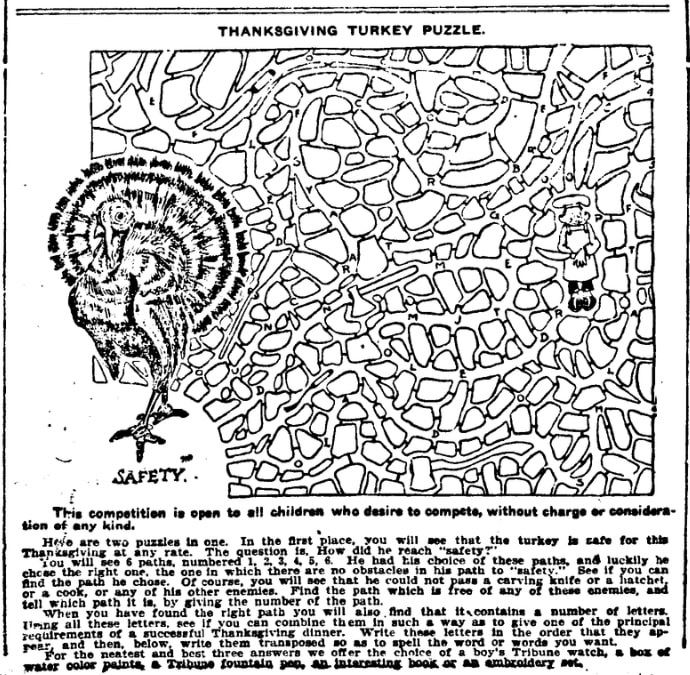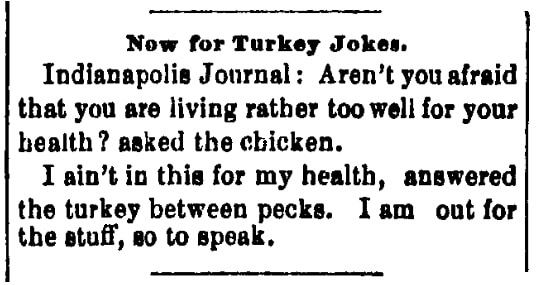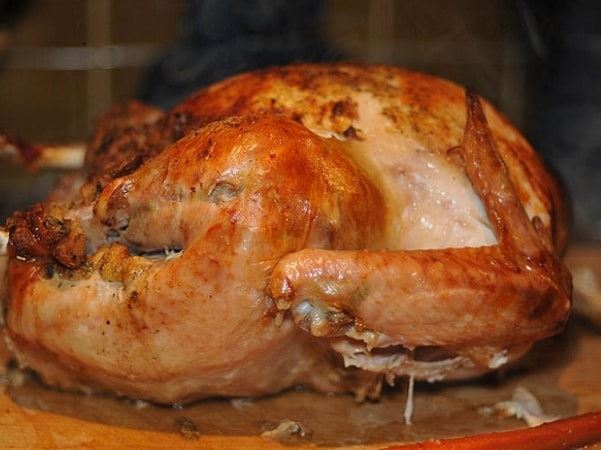Introduction: In this article, Mary Harrell-Sesniak searches old newspapers to find riddles and puzzles that entertained our ancestors for the Thanksgiving holiday. Mary is a genealogist, author, and editor with a strong technology background who has written and collected some of the funniest, quirkiest, or most touching sayings about genealogy that she’s encountered in her career as a family historian. Please attribute this article if sharing.
If you’d like to make Thanksgiving unique and entertaining for family of all ages, look to historical newspapers for fun ideas. Below you’ll find some of the puzzle and humorous finds I made by searching GenealogyBank’s Historical Newspaper Archives, starting with this Thanksgiving Turkey Puzzle found on a children’s activity page.

Riddles, Jokes and Conundrums
If you’ve got a funny bone, chances are you inherited it from an ancestor. They loved riddles, which were commonly described as conundrums and enjoyed by all ages. Let’s see how many of these Pilgrim and turkey riddles, plucked from a variety of early newspapers, stump your family! (Note: As the original authors were never identified and the same jokes appeared in numerous papers over many years, I have elected to list them without attribution.)

Q: What long name did one of the pilgrims have?
A: Miles (Standish)!
Q: Which part of Thanksgiving dinner opens the front door?
A: The tur-key!
Q: What part of the turkey is part of a sentence?
A: The claws (clause)!
Q: What part of the turkey assists a lady in making her toilet (getting ready)?
A: The comb!
Q: What broad letter did the Pilgrims travel on?
A: The C (sea)!
Q: What part of the turkey will appear the next day?
A: The bill!
Q: Why is the person who eats too fast like a turkey?
A: Both are gobblers!
Q: Why ought a turkey be ashamed when being served?
A: Because we see the turkey dressing!
Q: When the turkey is cooking, what country is it in?
A: Greece!
Q: Why should we think the first New England Pilgrim girls were bicyclists?
A: A number of spinning wheels were seen!
Q: What part of the turkey appears on the battlefield?
A: The drum stick!
Q: What part of the turkey is a story?
A: The tail (tale)!
Maskers
Since this is the year of masks, Google “maskers” and find photos at historical websites such as the Library of Congress. You can see from this photo that dressing up in costume for Thanksgiving was a favorite activity. Why not try this and also look for the many published stories about maskers in early 20th century newspapers.
What Day Do We Celebrate?
If you think Thanksgiving Day was always on the same day, turn this concept into an educational activity. You can see from this newspaper clipping that in 1852, it was celebrated on a variety of dates. Challenge your students to query newspapers to determine when the day finally became agreed upon by all states.
Sports
If you have family obsessed with football and other sports on Thanksgiving Day, maybe it’s genetic. A fun idea is to have students look up other examples of sport celebrations on Thanksgiving Day. Note how New Yorkers enjoyed their day in 1880! Not only was there shouting and singing, but there was also vociferous yelling while cheering on favorite teams. Women even joined in by dressing in team colors, such as the blue of Yale or the orange and black of Princeton.
Old Time Descriptions
Lastly, use GenealogyBank queries to discuss why or why not certain items are easy to find in old newspapers. My tip is to learn how our ancestors phrased things differently. Jokes were sometimes described as puzzles and at other times conundrums!
Happy Thanksgiving. We are very grateful for our followers who share in our love of old and interesting newspapers. Stay safe and let me know if you shared these jokes and activities with your family in person, via email or video chat!
Related Articles:
- Our Ancestors’ Humor: Halloween Jokes
- Our Ancestors’ Sense of Humor: Newspaper Jokes
- Mary’s Musings: Humorous Observations about Excited Genealogists
Remember: a fun holiday gift for genealogists would be my book of historical and original jokes available at Amazon, Lulu and other online retailers.
